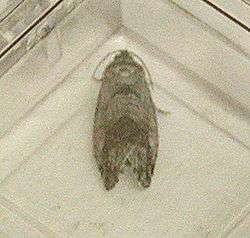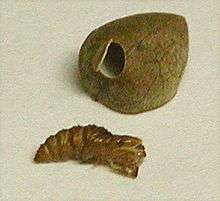Cydia deshaisiana
| Cydia deshaisiana | |
|---|---|
 | |
| adult C. deshaisiana | |
| Scientific classification | |
| Kingdom: | Animalia |
| Phylum: | Arthropoda |
| Class: | Insecta |
| Order: | Lepidoptera |
| Family: | Tortricidae |
| Tribe: | Grapholitini |
| Genus: | Cydia |
| Species: | C. deshaisiana |
| Binomial name | |
| Cydia deshaisiana (Lucas, 1858) | |
| Synonyms | |
| |

Cydia deshaisiana or jumping bean moth is a moth from Mexico that is most widely known as its larva, where it inhabits the carpels of seeds from several related shrubby trees, mainly Sebastiania pavoniana or Sapium biloculare (syn. Pleradenophora bilocularis).[1]. These seeds are commonly known as Mexican jumping beans.
The moth lays the egg on the young pod. The hatched larva gnaws into the seed, which closes the minute hole during its growth. The larva attaches itself to the bean with many silken threads by hooks on its anal and four hind abdominal prolegs. When the bean is abruptly warmed, for instance by being held in the palm of the hand, the larva twitches and spasms, pulling on the threads and causing the characteristic hop. "Jump" is often an exaggeration, but the beans nonetheless do move around quite a bit.
The larva may live for months inside the bean with varying periods of dormancy. It eats away the inside of the bean, making a hollow for itself. If the seed is cut, the larva will repair the hole with silk.
If the larva has adequate conditions such as moisture, it will live long enough to go into a pupal stage. In preparation to this, it eats a circular hole through the shell in February and closes it again with a silken plug. This is to enable the jawless adult moth to escape from the seed. After completion of the exit hole it spins a cocoon within the seed, with a passageway leading to the door. During the following pupal stage the larva will not move any more. Normally in the spring, the moth will force its way out of the bean through a round "trap door", leaving behind the pupal casing.
The small, jawless silver and gray-colored moth will live for only a few days.
Synonyms
Commonly used synonyms for the species are Carpocapsa saltitans or Laspeyresia saltitans — carpo indicating that it lives within a seed (see podocarp), and saltitans referring to its jumping behavior.
See also
- Calindoea trifascialis, a moth that jumps inside a rolled up leaf 'sleeping bag'[2]
- Colliguaja odorifera, a related jumping seed plant[1]
- Emporia melanobasis, a moth with similar habits, parasitizing in Spirostachys africana.
- the California jumping gall wasp (Neuroterus saltatorius) shows similar behavior in galls produced in several oak species, although during the pupal state.[3][4]
- Nanodes tamarisci, acting similarly in the seed of Tamarix.
- Sapium biloculare or the Arizona jumping bean, a related plant with jumping seeds[1]
- Spirostachys africana, the jumping seed parasitized by Emporia melanobasis
- Tortricidae, the family of moths containing many of the jumping species[1]
References
- (1876). Jumping Seeds and Galls. American Naturalist, Vol. 10(4): 216–218.
- 1 2 3 4 Webster, Grady L. (October 1967). "The Genera of Euphorbiaceae in the Southeastern United States". Journal of the Arnold Arboretum (GIF)
|format=requires|url=(help). 48 (4): 386–387. JSTOR 43782494. OCLC 3178505. - ↑ Humphreys, Kim; Darling, D. Christopher (21 August 2013). "Not looking where you are leaping: a novel method of oriented travel in the caterpillar Calindoea trifascialis (Moore) (Lepidoptera: Thyrididae)" (html). Biology Letters. 9 (5): 20130397. doi:10.1098/rsbl.2013.0397. ISSN 1744-957X. OCLC 5145587411. PMC 3971676. PMID 23966594. Retrieved 27 July 2018.
- ↑ "Jumping Galls". waynesword.palomar.edu. Retrieved 28 July 2018.
- ↑ Marshall, Michael (18 August 2014). "Zoologger: The secret hop of the Californian flea seed" (HTML). NewScientist. Retrieved 27 July 2018.